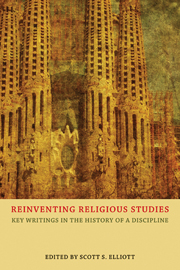Book contents
- Frontmatter
- Contents
- Introduction
- 1 For such a time as this: the Council of Societies for the Study of Religion, 1969–2009
- Part I Inventing and reinventing the field of religious studies
- 2 Why a Council on the Study of Religion?
- 3 Ironies
- 4 Religious studies: the next vocation
- 5 Impressions from Wingspread: religious studies—the state of the art
- 6 History of religions
- 7 The future of religious studies: moving beyond the mandate of the 1960s
- 8 Naming the game: a question of the field
- Part II Method and theory in religious studies
- Part III Teaching religion
- Part IV Women and the bible in religious studies
- Part V Religion and religious studies in civic life
- Part VI Religious studies and identity politics
- Part VII Islam and 9/11
- Bibliography
- Acknowledgments
- Index
8 - Naming the game: a question of the field
from Part I - Inventing and reinventing the field of religious studies
- Frontmatter
- Contents
- Introduction
- 1 For such a time as this: the Council of Societies for the Study of Religion, 1969–2009
- Part I Inventing and reinventing the field of religious studies
- 2 Why a Council on the Study of Religion?
- 3 Ironies
- 4 Religious studies: the next vocation
- 5 Impressions from Wingspread: religious studies—the state of the art
- 6 History of religions
- 7 The future of religious studies: moving beyond the mandate of the 1960s
- 8 Naming the game: a question of the field
- Part II Method and theory in religious studies
- Part III Teaching religion
- Part IV Women and the bible in religious studies
- Part V Religion and religious studies in civic life
- Part VI Religious studies and identity politics
- Part VII Islam and 9/11
- Bibliography
- Acknowledgments
- Index
Summary
The ambiguous phrase “theory and method in the study of religion” may be understood to apply either at a primary level, focusing on the study of religion, or at a secondary level, focusing on the study of religion—i.e., it may refer either to the object studied or to the character of the study itself. The first issue is that of the nature of religion, the second is that of the nature of the academically disciplined means for studying religion. Many or most of the articles in the Council on the Study of Religion Bulletin treat the latter issue. Never far from the surface of concern, whether at our own formal meetings or in casual encounters with colleagues from other academic domains, this question of the nature of the field has been pressing increasingly from the background to the foreground of scholarly interest. Conferences such as the annual gathering of University of California, Santa Barbara faculty, whose theme in February 1983 was “Religious Studies and the Challenge of the Eighties,” or the March 1983 convening of ACM/GLCA college faculty in non-Western religions, or the May 1983 meeting of historians of religions at the University of Chicago, are now often dominated by the issue. This should come as no surprise, for upon our corporate determinations may hinge both intellectual respectability in our own eyes and practical credibility in the eyes of other members of the academic community.
- Type
- Chapter
- Information
- Reinventing Religious StudiesKey Writings in the History of a Discipline, pp. 56 - 63Publisher: Acumen PublishingPrint publication year: 2013



